FURY,
FUMAROLES AND BRIMSTONE
The Japanese
Named It Sulfur Island.
The U. S. Marines
Called It (Censored)
----- by TONY
WELCH
For seven
months -- May through November, 1945 -- George E. Pickett
and three fellow sailors held sway over what would soon
become the world's most iconic and instantly recognizable
piece of real estate.
None of them
held a trust deed to the property, and yet this foursome
lorded over their patch of ground with all the authority of
a cop on the beat. Trespassers and interlopers were warned
away by a sign reading: "DANGER -- 5,000 VOLTS! KEEP
OUT.
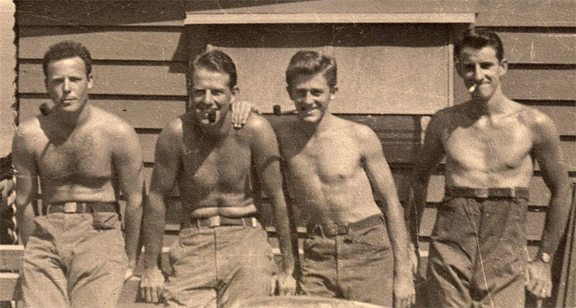
HIGH AND DRY:
Mountain-top sailors (from left): Robert Robertson, Charles
Shimmin, George Pickett and Robert Ray. Together, they set
up and maintained an elevated radar tower atop Mt. Suribachi
within 25 yards of the much-celebrated flag-raising
site
"Each time I
stepped out the front door of our Quonset hut, there was
this sprawling panorama five hundred feet below," Pickett
recalls. Not more than 35 feet away, an American flag danced
atop a new flagpole. "On a good day I could see clear to the
north end of the island, five miles away."
The island
referred to is Iwo Jima, and the viewpoint facing Pickett's
mountain home is exactly where the U.S. Marines planted the
Stars and Stripes atop Mount Suribachi. George first came
ashore on Iwo thirty-five days after the flag raising. He
would spend the next seven months treading the consecrated
ground upon which the eyes of millions became fixated --
thanks to a single photographic image.
THEN AND NOW:
A double dose of U.S. naval gunfire explodes on the crown of
Mr. Suribachi a day before the invasion. The salvo just to
the right is very close to the future flag-raising site. The
crest of Suribachi as it appears today; the speck of white
is the memorial dedicated to all who lost their lives on
Iwo.
Pickett's
assignment -- classified Top Secret -- was to help make Iwo
and its surrounding waters a more secure place by
introducing radar to the island, which technical advancement
had proven invaluable at sea during surface engagements with
the enemy. Initially trained as a radio technician, George
went through a further 18 months of radar instruction before
being assigned to a sector known as GROPAC 11 -- Group
Pacific Eleven. GROPAC's hush-hush mission was to install
elevated radar-ranging equipment on certain specified
islands throughout the Pacific. Pickett and a boatload of
technicians departed San Francisco on February 1, l945
aboard a Dutch vessel and crew leased to the U.S. Army. "We
stopped at five islands in all, over a period of sixty
days," Pickett notes. "While underway at night we had to
take turns manning the crow's nest, because the ship had no
radar. Would you believe we got paid extra for that? --
fifty cents an hour. When we arrived at Iwo on April first,
a large group of departing marines came aboard and we went
ashore in their LSTs. I left the ship with sixty bucks, cash
in hand. Never could figure that one out."
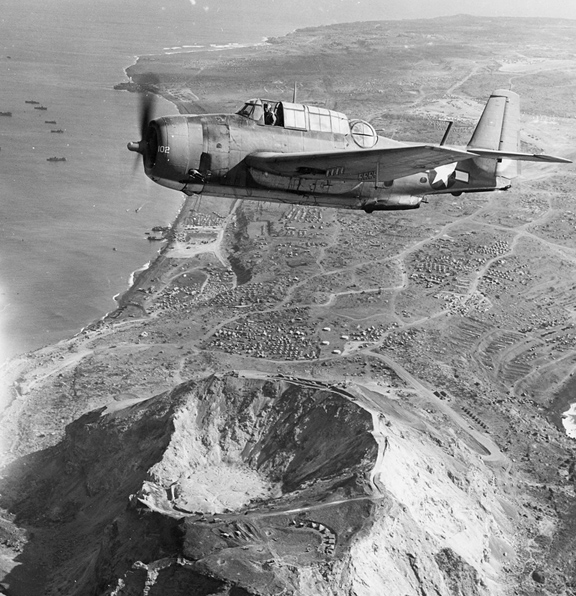
SCENE FROM
ALOFT: An Avenger torpedo bomber pilot, flying from
an offshore aircraft carrier, takes in an eagle eye view of
Mt. Suribachi three weeks after D-day.
On his first
morning ashore, George carefully picked his way across a
mutilated landscape. Knowing virtually nothing of the
unrestrained violence that preceded his arrival, Pickett was
suddenly brought up short by an open trench layered with
Japanese soldiers. An obviously hardened Seabee bulldozer
operator repeatedly ran his tracked vehicle back and forth,
gradually filling the gravesite. One of many mass burials,
as it turned out. Pickett's second rude awakening came when
he learned that beneath the island's surface of volcanic
pumice were thousands more entombed Japanese, scattered
along eleven miles of tunnels and in innumerable caves. An
alarming number of them, as the Marine invaders were quick
to discover, remained very much alive and aggressively
combative.
Less than a
week prior to Pickett's arrival, a force of 350 determined
survivors left their underground labyrinth and in the
pre-dawn hours of March 27 infiltrated the Marine lines
undetected. Pausing briefly to regroup, they then assaulted
the sleeping quarters of the 7th and 21st Fighter Groups.
Amidst total confusion, the groggy Mustang pilots suddenly
found themselves overrun and outnumbered. Within the
spread-out tenting area, chaos reigned. In one encounter,
some cooks armed only with long-handled soup ladles and
other kitchen utensils drove six Japanese out of the mess
tent -- and lived to tell about it. From outside the
perimeter, U.S. ground crews and other support personnel
quickly joined the fray. The frenzied Japanese ransacked the
area, tossing grenades inside tents and then gunning down or
bayoneting any survivors attempting to flee. When the
skirmish finally ended at mid-morning, 330 Japanese lay
dead; those not killed committed suicide. Forty-four U.S.
pilots and support personnel died, with another 100 wounded.
The encounter marks the only known WW11 engagement between
aviators and infantry. "Our own tents near the airfield were
only a few hundred yards away from where the attack took
place," Pickett remembers. "That's when we starting posting
armed sentries at night."
In consequence
of the mounting death toll on both sides, hundreds and then
thousands of bloating bodies became feeding and breeding
grounds for millions of flies. Marine and Seabee sanitation
teams, often under fire themselves, quickly fell behind in
their recovery efforts. In a moment of inspiration, a pair
of C-47 cargo planes was outfitted with improvised spraying
equipment. The aircraft made repeated low-level passes over
Iwo's terrain, leaving in their wake misty clouds of DDT.
The disease-carrying fly population -- just one more threat
to human health -- plunged dramatically. The bushido-driven
Japanese proved far more resilient.
GROPAC's first
project, at the far north end of the island, was to install
seventeen radio transmitters for the joint Army/Navy
Communications Center. Each transmitter was equal in size to
a refrigerator; the condensers stored within were wired and
bundled, then each unit connected in sequence. "It took
close to a month to complete," George notes. "After we
finished, the Navy officer in charge went out to a ship and
brought back a pile of steaks that we cooked up on a grill
-- his way of saying thanks. And I got advanced to petty
officer second class."
|
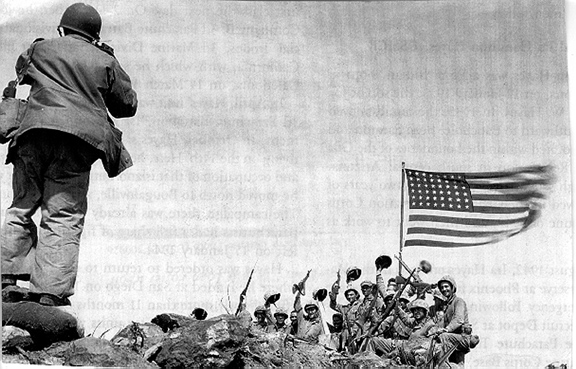
|
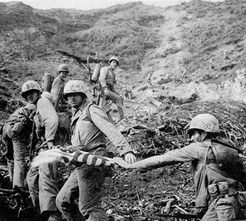
|
CHEESE
PLEASE: A.P. photographer Joe Rosenthal records a picture of
the Suribachi flag raisers. But it's not this posed image
that would capture America's heart and soul and later earn
him the Pulitzer Prize. The Associated Press, in an
unprecedented gesture, donated all proceeds from the sale of
Rosenthal's famous grab-and-shoot photo to the Navy Relief
Society -- a total of $12 million over ten years. At right,
Easy Company marines climb Suribachi's north flank with the
first of two flags flown that day.
Next stop:
Suribachi. Within the walls of its volcanic cone -- as well
as along the steep slopes rising 550 feet above the island
floor -- dozens of cave entries were discovered shortly
after the flag raising. Flame throwers and dynamite satchel
charges were lugged up the mountainside. In one cave alone,
by actual count, 142 charred bodies testified to the
effectiveness of flammable napalm. How many cave dwellers
remained was anyone's guess, connected as some caves were to
tunnels leading downhill to the island itself. But for the
moment all was peaceful on the mountaintop -- and there was
every hope that it would remain so.
"A
construction battalion roughed out a two-lane road up the
mountain, and we used our assigned weapons carrier to haul
all our gear and unassembled parts," Pickett explains. "The
winding mile-long road ended about fifty feet below the
highest point of the volcano's rim, on a leveled plateau." A
just-erected but empty Quonset hut -- home sweet home --
greeted the quartet.
Adds George:
"The Seabees also built a four-hole outhouse nearby, so that
each one of us had his own throne." Pickett seriously doubts
if any prowling Japanese ever used it. "One of the first
things we did was build a shower stall, using a 150-gallon
external fuel tank from a P-51 Mustang fighter plane. Shaped
like a teardrop. We installed the tank on top of the shed
that housed the motors that ran the electric generators.
Talk about king of the hill!"
Pickett on
more than one occasion expressed delight at finding himself
in a war in which he was totally ignored by the enemy. "I
never once got shot at!" he'd exclaim, feigning
disappointment at being short-changed -- but in reality
profoundly grateful, as evidenced by a toothy grin.
Nearby, a
thirty-foot steel tower loomed above the compound. The plan
was to attach the radar oscillator at the top, then follow
through with all the necessary connections to the electronic
apparatus packed away and waiting assembly.
With a
Raytheon company technician standing by, the four-man team
finished the complex task in a week. To Pickett's surprise
and delight, the radar apparatus immediately came to life
and did what it was intended to do: detect any approaching
or passing surface vessel within 35,000 yards. The great
majority of Allied shipping in that theater of war was
equipped with a sensor that automatically returned a coded
signal to the GROPAC station atop Shuribachi. Any vessel
under radar scrutiny that failed to respond was presumed to
be unfriendly. "The Army Air Corps on the island operated
similar radar towers to detect approaching enemy aircraft,"
George explains. "I remember seeing B-29s taking off and
landing on our radar screen as the revolving oscillator
picked them up. It only broke down once during the seven
months of continuous operation." A nearby duo of gasoline
generators supplied 5,000 volts of electricity to the
system.
Pickett
graduated high school in Wheeler, Oregon at age 16, then
went to work for a journeyman carpenter in need of an
apprentice. By the time he enlisted in the Navy on his
twenty-first birthday -- and newly married to boot -- George
was thoroughly familiar with residential construction,
having helped erect five dwellings. He also delved into wood
carving and furniture making, a vocation he was to pursue in
later life.
Standing alone
in the empty 20x48-foot quonset, George quickly sketched out
a workable interior design. "I set aside one-quarter of the
space for us four guys. Then half of the hut to hold all the
radar gear. The last section went to house Joe Hayes, the
lieutenant jay-gee in charge. Hayes was an OK fellow, a
school teacher from the Midwest somewhere. He was seldom
aroundÉleft us pretty much alone. And would you
believe -- he didn't drink! Sweet man -- he sold us his
weekly booze allotment for the same price he paid for it."
Hard liquor, especially well-aged bourbon, was the currency
of choice on Iwo. Nothing else of value came close,
excepting genuine Japanese flags, sidearms and samurai
swords for which the liquor was eagerly traded.
With lumber
and tools supplied by the Seabees, Pickett partitioned off
the quonset and then proceeded to furnish the interior. He
designed and constructed four spacious bunk beds (no army
cots for these swabbies). Then a table and chairs, plus a
large dresser with four drawers, one for each occupant.
Further personal touches followed, and living began to
resemble more of a peacetime setting than a war
zone.
HANDY ANDY:
George Pickett's woodworking skills are evidenced by a
homemade lamp and bedroom dresser, plus an array of bunk
beds to brighten the Quonset hut. The skull and warning sign
(center) serve as grim reminders of the war being waged --
literally underfoot. The samurai sword was 'rescued' from a
subterranean Japanese bunker.
Making the
best of it atop Mount Suribachi wasn't all domestic
tranquility, to be sure. During installation of the radar
tower, a human skull was unearthed -- undoubtedly Japanese.
"We decided to hang it just below the posted danger sign on
the tower, to give the warning further emphasis. Somebody
came up with the bright idea to insert two lights within the
empty eye sockets. The lights served to illuminated the
skull and warning sign at night." The adornment must have
done its job, George reflects, because to his knowledge no
surviving Japanese lurking in caves within the mountain ever
came snooping around the premises. For a final touch, a pair
of eye glasses was added -- after all, weren't all Japanese
born near-sighted? Newspaper and magazine cartoonists early
in the war liked to portray them wearing inch-thick
spectacles. "That's what everybody was led to believe back
then," Pickett notes. "That is, until the shooting started."
|

|
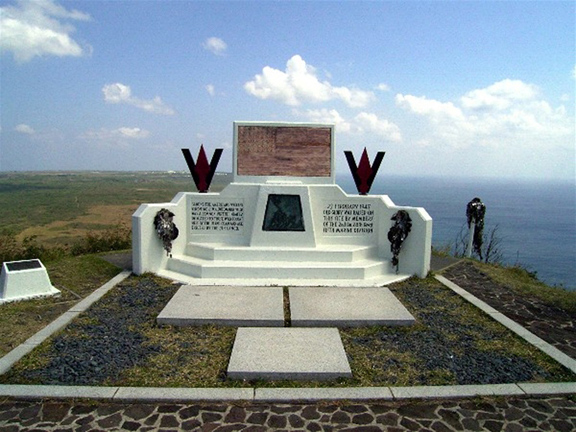
|
ABOVE AND
BEYOND: Custom-designed and built by the 31st Naval
Construction Battalion (Seabees), the Suribachi memorial was
dedicated October 2, 1945 by a U.S. Army occupational
detachment. The flag was later replaced by a bas-relief
bronze tablet, seen here.
A group of ten
Navy radar operators took turns commuting to the
mountaintop. Their task: monitoring the radar scopes 24/7,
while Pickett's on-site crew of four maintained the power
plant and electronic equipment. One of the radar operators,
a second-class petty officer named Jack Gary, decided to
fill his off-duty time with a new hobby. Armed with a
portable tank of oxygen and connective breathing tube (plus
a lantern and .45-calibre sidearm), Gary began exploring
unsealed caves and tunnels he thought reasonably safe to
enter. Not for nothing had the Japanese named this place Iwo
(Sulfur) Jima (Island). Ascending sulfur fumes from hundreds
of fumaroles scattered across the devastated landscape
provided a constant reminder that 'Iwo was hell -- without
the fire,' as one Marine aptly put it. The highest
underground temperature ever recorded on Iwo was 156F; even
more troublesome, nowhere on the island was there a natural
source of drinking water.
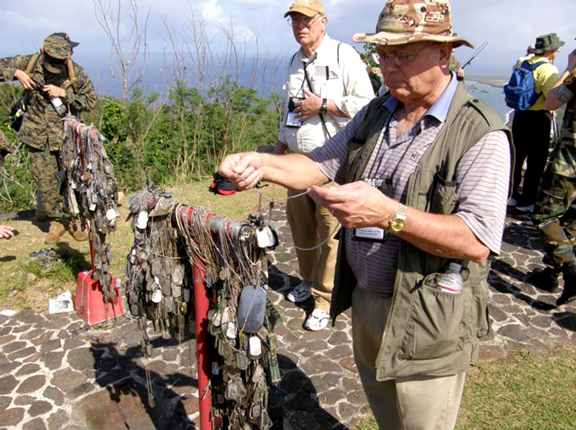
IN
REMEMBERANCE: Returning Iwo veterans often leave their dog
tags as a symbolic tribute
to fallen comrades.This 2010 anniversary tour consisted of
26 vets ranging in age from 83 to 97
(photo courtesy Vernon Martin, "Sgt., USMC)
"I went along
with Jack a couple times," says Pickett. "We navigated one
of the tunnels and it finally opened up into a rather large
excavation. I think it might have been a hospital, or
emergency room." Slumped along a bench against one wall, a
dozen Japanese soldiers in the first stages of mummification
testified to the utter hopelessness and despair of their
troglodyte existence. "One of them had his arms folded
around a samurai sword," Pickett continues. "Jack scooped
that up in a hurry, and then he proceeded to look for wrist
watches. Finally, he got out a pair of pliers and started
yanking all the gold teeth he could find. He later made
rings out of monel, a nickel and copper alloy, with some of
the better gold teeth mounted in the center. I don't
knowÉthat's just the feeling some guys
hadÉalmost an automatic reflex. No more regard than
if the Japs were animals."
Then came a
day in late November; time to pack it up and pack it in.
George remembers: "We carefully dismantled all the
classified radar equipment and boxed it, well padded and
secure. And that included the skull from the tower, in its
own special container with the eyeglasses and all. Lord
knows, thoughÉour shipping containers probably ended
up at the bottom of the ocean -- just another pile of
post-war surplus." Pickett gave the room a final once-over,
then walked through the open doorway for the last time and
across the hallowed ground, clutching his seabag.
Part fantasy,
part Dante's Inferno, part netherworld -- the imagery of Iwo
Jima will likely remain in the American consciousness for a
very long time. As in: "My great-great-great-great
grandfather fought on Iwo Jima." George Pickett well knows
he got but a whiff of what transpired there, and is ever
grateful for being spared the savagery* that engulfed so
many others of his generation.
George
Pickett at age 22, and now a spunky 88. George and his wife
Thelma have been wed 68 years, and reside in a suburb of
Portland, Oregon. Coincidentally -- or perhaps
intentionally? -- sons Mike and Harold both served in
Vietnam as electronic technicians. One Navy, one
Marines.
*For each of
Iwo's eight square miles, 3,255 American servicemen were
killed or wounded. Add to this figure 21,060 Japanese
casualties, and the total exceeds 46,000
dead/wounded/missing in action over a 45-day period.
Recovering A Nation's War
Dead...
|
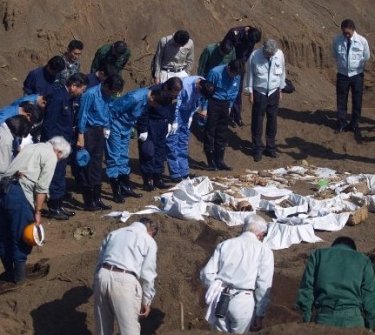
|
"Japan's prime minister
and other officials gather to pray at a newly
discovered Iwo Jima mass gravesite on December 14,
2010. More than 12,000 fallen Japanese
soldiers have yet to be recovered from the
island."
|
E P
I L O G U E: YOUR WEBMASTER -- THAT'S ME, JOE RICHARD
-- VISITS SURIBACHI ONE LAST TIME, WHERE HE SAT OUT A
PASSING THUNDERSTORM (see below). GEORGE PICKETT DID
THE SAME 21 YEARS EARLIER -- BUT HIS STORM TURNED INTO A
CLASS 3 TYPHOON THAT TOPPLED HIS QUONSET
HUT.
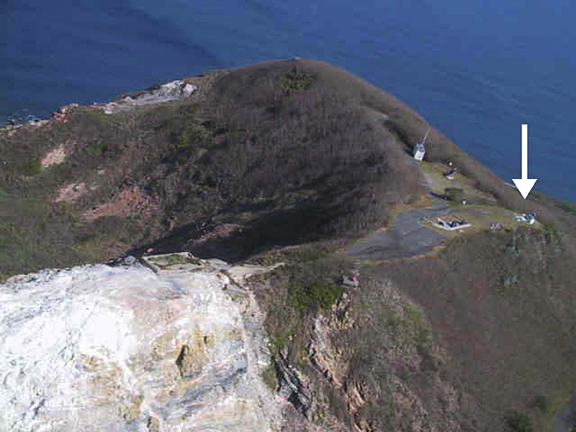
Large version of one of the images in Mr.
Pickett's story: In looking at the above image, you will
see the white arrow that points to the spot where the flag
was raised during the early days of the battle for the
island. If you look to the left of the arrow and almost
halfway and slightly lower in this photo, you will see a
small concrete structure. That is the observation post where
I waited out the storm. Moving further to your left, you
will see a white area with what appears to be a square
concrete structure. One of the images below was taken
there.
Webmaster
note: Back in 1966, a few days before leaving Iwo Jima for
home, I hitched a lift to the summit where a crew was headed
up to change the beacon light on top of Mt.
Suribachi.
While up on
the summit, we could view some thunderstorms that were
building and were headed directly towards the island. It was
quite a sight to see.
The guys
finished up the bulb replacement and were ready to head back
down before the storm arrived. I elected to stay on the
summit and utilize the observation post (located mid center
of image above) and wait out the storm. Over their
objections, I stayed.
The shower
approached and passed directly over the island with the
ragged base BELOW the summit of Suribachi.
Taking refuge
in the observation post, I snapped some shots of the rain
and cloud base as it passed over me.
Some of the
images are shown below.
|
|
|
|
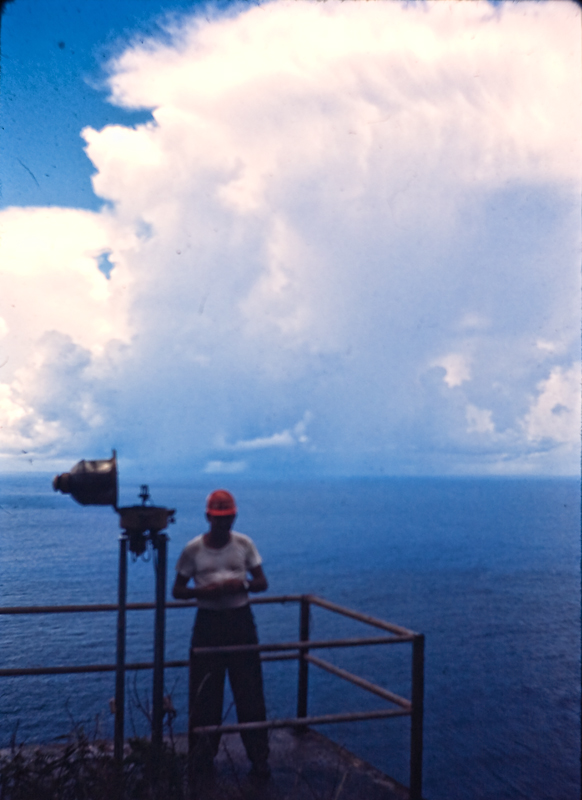
Replacing the bulb atop
the observation post.
T-storms advancing towards island in the
background.
|
|
|
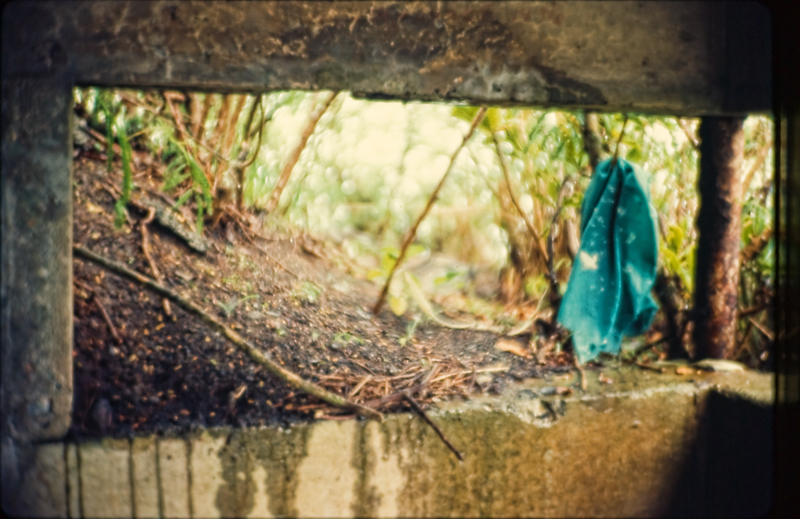
Inside the observation
post as storm passes overhead.
|
|
|
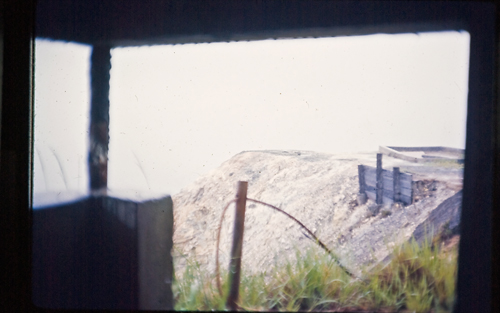
...from inside the
observation post looking towards broken concrete
structure.
|
|
|
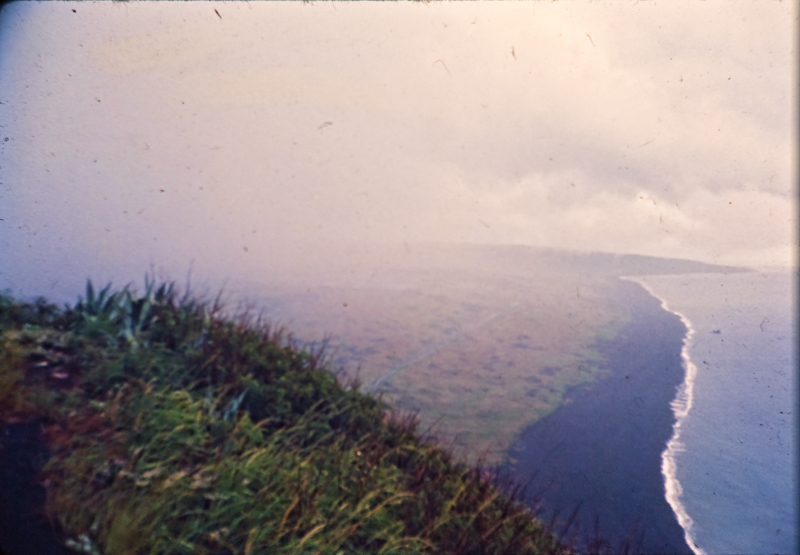
The showers passing over
the invasion beaches.
|
|
|
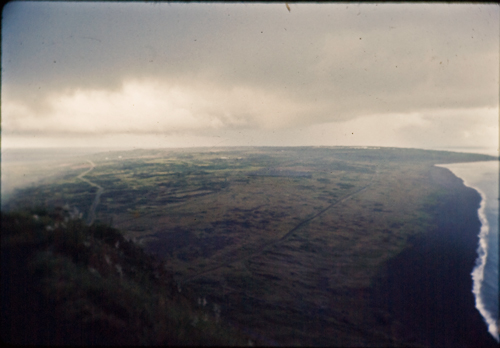
Showers ending above
island.
|
|
|
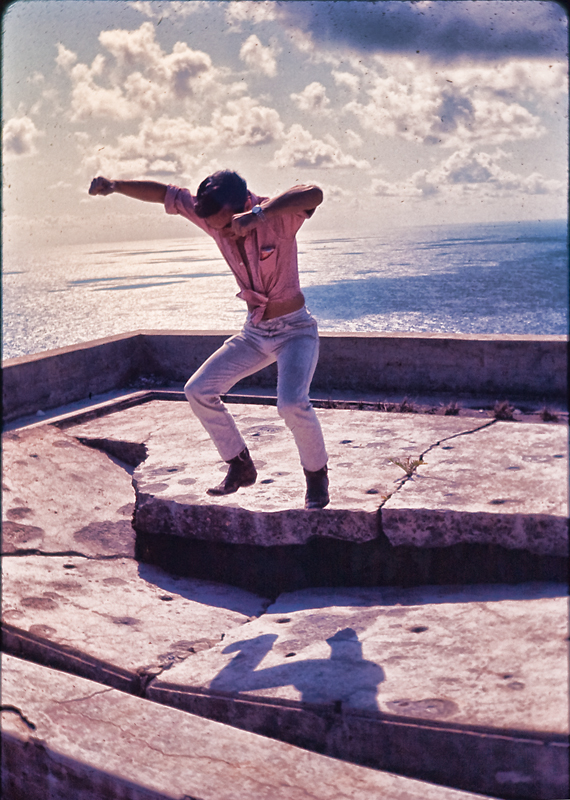
...concrete structure
shown in original photo above.
|
|
Note:
To view images taken by the web master on World War II
Stories -- In Their Own Words during his year on Iwo Jima,
please click on the following link to my World War II
Stories Photo Album:
WW
II Stories: Iwo Jima Photo Album
1965-1966
Did YOU serve on Iwo Jima?
Did you
know that there is a group of veterans who have gotten
together to form an association of servicemen, no matter
what branch of service, who served at one time or another
starting at the invasion of the island on February 19, 1945
and continuing until the island was eventually returned to
the Japanese in 1968?
Iwo
Veterans Organization
We, at
the Iwo Jima Memoirs web site wish to
offer to Mr. George Pickett our most profound THANK YOU for
his poignant story of his personal experiences -- during his
tour of Iwo Jima and especially for allowing us to share
those memories.
Original story transcribed on 14 September 2011
Did YOU serve on
Iwo Jima?
Do
YOU have a story to tell?
Do YOU
have a picture or pictures
that tells a story?
Contact me, Joe Richard and I can help by
adding YOUR story to my site devoted to veterans who served
on Iwo Jima.
Check out my
other web site on World War II. Click on the Image
Below:
